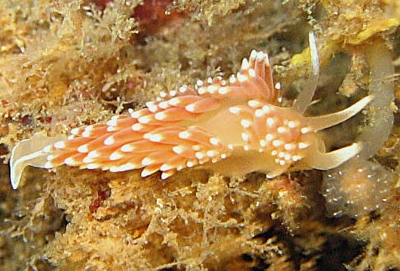
Flabellina falklandica
(Eliot, 1907)
Order: NUDIBRANCHIA
Suborder: AEOLIDINA
Family: Flabellinidae
DISTRIBUTION
Wide distribution in the southern Ocean (Magellanic region [sthn South America from River Plate, Argentina to 30°S, Chile], Falkland Islands, South Georgia, and Crozet Island.)
PHOTO
This photo was taken by Michael Schroedl during "Huinay Fjords Expedition 2006") at depths between 10 and 20 m and temperatures steadily below 10 °C [off the southern Patagonian iceshield ].
Translucent yellow orange, with white tips to the smooth rhinophores, oral tentacles and cerata. White line borders the posterior part of the foot, and there is a white median line running forward a distance, from the posterior tip of foot. The cerata are arranged in transverse rows of 5 or 6 cerata on each side, the rows being grouped into clusters, one forward of the pericardium, and about four posterior to the pericardium on each side.
In Eliot's description he describes the colour as 'uniformly yellowish or greenish white, with traces of white lines on the tail of one specimen'. Although this description is probably based on the preserved specimens, the white lines on the posterior foot appear to be a good character for this species. It grows up to 40 mm in length [Schroedl, 2003].
-
Eliot, C.N.E. (1907) Nudibranchs from New Zealand and the Falkland Islands. Proceedings of the Malacological Society of London, 7(6): 327-361, Pl.28.
-
Odhner, N.H. (1926) Die Opisthobranchien. In: Further Zoological Results of the Swedish Antarctic Expedition 1901-1903 under the direction of Dr. Otto Nordenskjold. Vol. 2(1). P.A. Norstedt & Söner, Stockholm, 1-100. (Pls. 1-3)
-
Odhner, N.H. (1944) Mollusca: Nudibranchia and Scaphopoda with zoogeographical remarks and explanations. Det Norske Videnskaps Akademi i Oslo. [In:] Scientific results of the Norwegian Antarctic Expeditions 1927-l928 et seq. Vol. 2(21). I Kommisjon hos Jacob Dybwad., Oslo, 1-48, Pl.1.
-
Schroedl, M. (2003) Sea Slugs of Southern South America. ConchBooks, Hackenheim. 1-165.
Rudman, W.B., 2007 (March 13) Flabellina falklandica (Eliot, 1907). [In] Sea Slug Forum. Australian Museum, Sydney. Available from http://www.seaslugforum.net/find/flabfalk
Related messages
Flabellina falklandica and Notaeolidia
March 14, 2007
From: Michael Schroedl
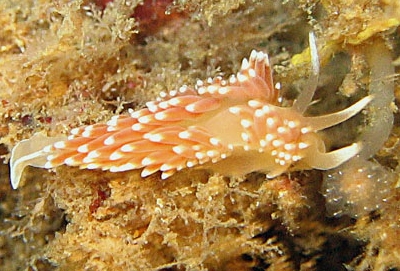
Hi Bill,
Thanks for your request for information on southern species of Flabellina. Our paper on Sth American Flabellina is taking a long time - almost ready. David Cothran's photos [message #19538] show a specimen having propodial tentacles and to my knowledge such structures have never been reported from Notaeolidia. And there are many cerata, and arranged continuously; would be good to have a pic with a dorsal view, i.e. to see whether or not cerata are arranged along the notal edge in a few rows only; doesn't seem so from the pics but may be because of the angle of view. N. gigas may have up to 4 cerata per "row", and the specimen on the pic may have 5 (4 plus a very small one). What's the size of that animal?
I think you are right in doubting that its is a Notaeolidia! It resembles Flabellina falklandica a bit, which is already known to have a wide distribution in the southern Ocean (Magellanic region, South Georgia, and even Crozet Island). Last year we found F. falklandica to be abundant in fjords and channels off the southern Patagonian iceshield (the included photos are of animals that I took during the "Huinay Fjords Expedition 2006") at depths between 10 and 20 m and temperatures steadily below 10 °C. It would be good to have an Antarctic specimen for external and internal comparision ...
However, I think Nobert Wu's "N. gigas" specimens [message #19612] are Notaeolidia rather than Flabellina. Rhinophores are long and more or less wrinkled or annulated according to the state of contraction, cerata are short in relation to body size and head tentacles, cerata appear restricted to the notal margin at least in the lower pic, specimens (at least lower one) are large, propodial tentacles are not visible, coloration differs from what I have seen in southern Flabellina etc. They are not N. depressa, that's for sure. Anyway, I' ve never seen living N. gigas or N. schmekelae other than those pics on the Forum, so difficult to give a positive statement on their id.
To be sure about potentially hidden tentacles I had a quick look at about 20 preserved Notaeolidia depressa in our ZSM collection: no propodial tentacles detactable. In contrast, preserved F. falklandica specimens show easily seen propodial tentacles. Some time ago I tentatively assigned a specimen photographed and collected by Dirk Schories at King George Island to N. gigas. From the photographs [see: http://www.guiamarina.com/antarctica/] and the preserved specimen which is in our collection: it has many cerata along the undulating notal margin, possibly up to 5 rows; and its has a wide cerata-free space on the central notum. No propodial tentacles were detectable.
All the best for now,
Michael
schroedl@zi.biologie.uni-muenchen.de
Schroedl, M., 2007 (Mar 14) Flabellina falklandica and Notaeolidia. [Message in] Sea Slug Forum. Australian Museum, Sydney. Available from http://www.seaslugforum.net/find/19656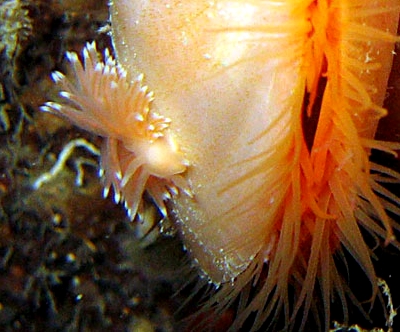
Dear Michael,
Thanks very much for the photos of F. falklandica and your considered thoughts concerning David's animal. I must say, I still have doubts about Norbert Wu's N. gigas.
In colour and ceratal arrangement, David Cothran's animals seem to fit your photos of F. falklandica very well. We can't see whether there is a break between the anterior rows of cerata and the post-cardiac rows, and we know nothing of its anatomy - but with those provisos, I think I will identify it as F. falklandica
In a separate message [#19540 ] are photos from David Cothran of animals which match Norbert Wu's N. gigas [see message #19612 ].
Best wishes,
Bill Rudman
Flabellina falklandica? from South Georgia
March 14, 2007
From: David Cothran
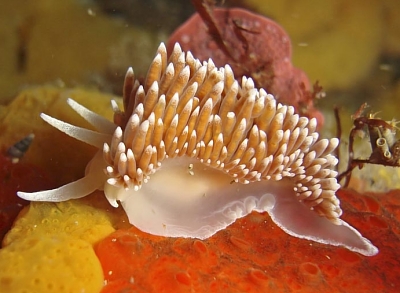
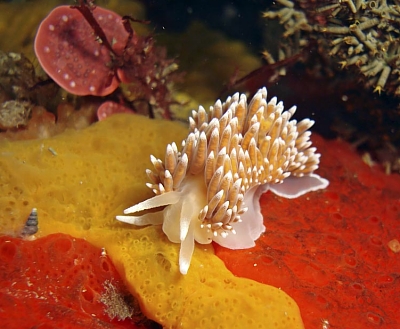
Hi Bill,
Here's another up to the minute report from the Antarctic. I dove today at Grass Island, in Stromness Harbor, where Shackleton finished his epic journey from Elephant Island. On the steep rock wall there I found several(>10) individuals of this species. It seems to be quite common at South Georgia; I have seen it at a number of localities here, but not anywhere in the South Shetlands or the Peninsula region. Most of the individuals I saw today were on Dideminidae ascidians like this one, but in the past I have
seen this species feeding on athecate hydroids.
What do you think of it? I have seen a BAS document with a superficially similar animal labeled as Eubranchus sp., but that seems pretty questionable to me. To my eye it strongly resembles a Notaeolidia sp., maybe N. gigas.
Locality: Grass Island, Stromness Harbor, South Georgia, Southern Ocean. 6 meters. Length 7 cm. 24 February 2007. Rock wall. Photo: David Cothran
Thanks as always for your assistance.
Best Regards,
David Cothran
david@wandering-eye.com
Cothran, D.B., 2007 (Mar 14) Flabellina falklandica? from South Georgia. [Message in] Sea Slug Forum. Australian Museum, Sydney. Available from http://www.seaslugforum.net/find/19538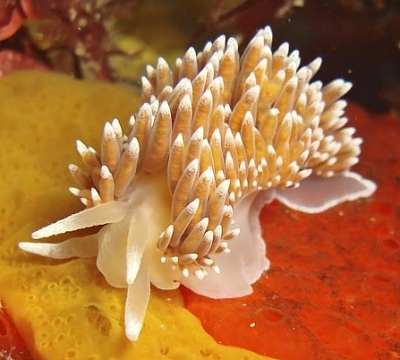
Dear David,
This is another interesting find. I didn't post your message immediately because I have been trying to get advice from others with more experience in this fauna. The thing that struck me immediately were the small tentacular 'foot corners' at the front of the foot [also known as propodial tentacles]. Species of Notaeolidia have rounded foot corners so this is not a species of Notaeolidia. The only other largish aeolids known from these waters are species of Flabellina so I sent copies of your photos to Michael Schroedl who has been studying South American species of this genus with Sandra Millen [see separate message #19656 ].
Although Michael is a little more hesitant than me, I suspect your animal is Flabellina falklandica. It seems to agree with his photos in all the main details, including the white line around the edge of the posterior foot and up the midline as well.
Best wishes,
Bill Rudman
